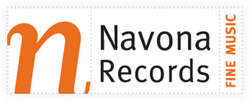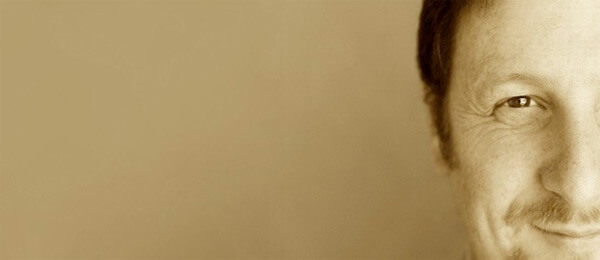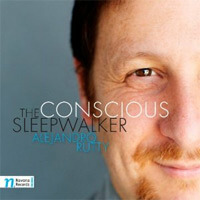 Alejandro Rutty’s new album The Conscious Sleepwalker is both a tour de force of the tango form, a deconstruction and re-imagining of that musical tradition. The grand, genre-spanning and genre-breaking ambitions of Rutty’s music are fully realized thanks to the precise and passionate execution of the performers. The album features two saxophone quartets, Cuarteto de Saxofones 4mil and Red Clay Saxophone Quartet, as well as 3 orchestral ensembles, the Mayan City Sinfonietta, the Moravian Philharmonic Orchestra, and the Kiev Philharmonic.
Alejandro Rutty’s new album The Conscious Sleepwalker is both a tour de force of the tango form, a deconstruction and re-imagining of that musical tradition. The grand, genre-spanning and genre-breaking ambitions of Rutty’s music are fully realized thanks to the precise and passionate execution of the performers. The album features two saxophone quartets, Cuarteto de Saxofones 4mil and Red Clay Saxophone Quartet, as well as 3 orchestral ensembles, the Mayan City Sinfonietta, the Moravian Philharmonic Orchestra, and the Kiev Philharmonic.
Since its first recognition as a distinct form in the 19th century, tango (both the dance and the music) has spread around the world and continued to develop and evolve. The tango composer most well-known to many listeners today, Astor Piazzolla, brought elements of jazz and even classical music into what had been a folk form. Rutty, building on the work of other tango experimentalists, goes even further, not only conceptually, but temporally and instrumentally as well. The “temporal” part comes from the beginning of the album, A Future of Tango, which is a three movement concerto for saxophone quartet (with orchestral backing) in which each movement represents what tango may sound like in a different, future year.

Alejandro Rutty
The very opening of the first movement, 2045: Mind Transfer Tango, is reminiscent of the soundtrack to a big Hollywood action movie, with a loud percussive hammering out of repeated eighth notes. But this syncopated pounding soon gives way to a somewhat traditional tango melody, spread out among the saxophones and the ensemble (using a four-person ensemble as a “soloist” was a brilliant move, because it means that at any moment the primary focus can be in almost any register, or even on a chordal passage.) After a wild romp around the scales, there is a moment of seeming calm, underlaid with mystery, which bursts wide open like a breached river dam into a sort of leaping melody supported by an insistent percussion line.
Much of the music on this album alternates between furiously driving rhythms and sly, slinky, slow melodic passages. The slow sections are effective because of the way they contrast with the energy of most of the music. Although they do function in the standard way of giving the audience a moment to breathe or reflect, I sometimes found they drew me in deeper, like an unexpectedly profound line uttered by an otherwise straightforward protagonist in a thriller. Furthermore—to further abuse the action move simile—the transitions back to faster rhythms made the apparent pauses seem like deceptive setups to exciting plot twists.
Sometimes, as in the final track, Tango Loops 1, Rutty blends the first-introduced fast and slow themes together later on in the piece, with, say, a threatening quick bass line accompanying a lyrical clarinet solo. The different moods perform quick exchanges, and individual themes move seamlessly among the players. It is as if Rutty is playing with tango’s two faces, the languorous and the passionate, and seeing if he can get the line between those moods to blur and ultimately disappear.
 Another feature of Rutty’s distinctive style is his use of counterpoint in which the accompanying line is dissonant yet still recognizably complementing the primary melodic material. Most strikingly, the end of one of the slow parts of Mind Transfer Tango uses the extreme high register on the soprano saxophone as a sort of descant—this is a searing, yet effective, move, mainly because it’s brief and not overdone. In fact, it was downright enjoyable to hear a brief callback to that bold gesture during the concerto’s slow second movement, 2098: Wartime Tango. Meanwhile, the last movement, set a century after the first (and on the planet Mars!), is both danceable and eerie. The swells of the strings, the wails of the saxophones, and the constancy of the drums all intersect to make for a memorable musical journey to the red planet, that ends with a surprising yet satisfying reprise of the opening of the very beginning.
Another feature of Rutty’s distinctive style is his use of counterpoint in which the accompanying line is dissonant yet still recognizably complementing the primary melodic material. Most strikingly, the end of one of the slow parts of Mind Transfer Tango uses the extreme high register on the soprano saxophone as a sort of descant—this is a searing, yet effective, move, mainly because it’s brief and not overdone. In fact, it was downright enjoyable to hear a brief callback to that bold gesture during the concerto’s slow second movement, 2098: Wartime Tango. Meanwhile, the last movement, set a century after the first (and on the planet Mars!), is both danceable and eerie. The swells of the strings, the wails of the saxophones, and the constancy of the drums all intersect to make for a memorable musical journey to the red planet, that ends with a surprising yet satisfying reprise of the opening of the very beginning.
There is much, much more I could say about the music, but I should take a moment to talk about The Conscious Sleepwalker CD’s enhanced content. I had some complaints about the digital extras on the last album from this record label that I reviewed. While I am pleased to report that some of what is included here is much more complete and useful, such as the thorough liner notes for each track, as well as two bonus music MP3s, problems remain. There are .jpg files of the scores of A Future of Tango and The Conscious Sleepwalker Loops. Each page of these scores, however, is a separate file! It is possible to highlight all of them at once and open them into a single frame in Preview, but this causes problems with zooming. Speaking of which—and more problematically—the resolution of the files is too low for the notation to be examined in any detail. Why go to the trouble of including these scores, if they’re only going to appear in such a compromised form?
The Conscious Sleepwalker is, as the title implies, full of contradictions: both rooted in tradition and deeply original, both avant-garde and fun to listen to. Alejandro Rutty envisions a future in which tango is still a major and still distinct art form, yet one that continues to draw on a variety of musical traditions, including but by no means limited to contemporary classical’s penchant for moments of dissonance and metrical shifting. With this album, he is himself contributing greatly to the likelihood of that future’s existence.
Alejandro Rutty, The Conscious Sleepwalker (Navona Records, 2012) | Buy it on Amazon
—
Matt Weber is a New York based composer, educator, and political slacktivist.





















